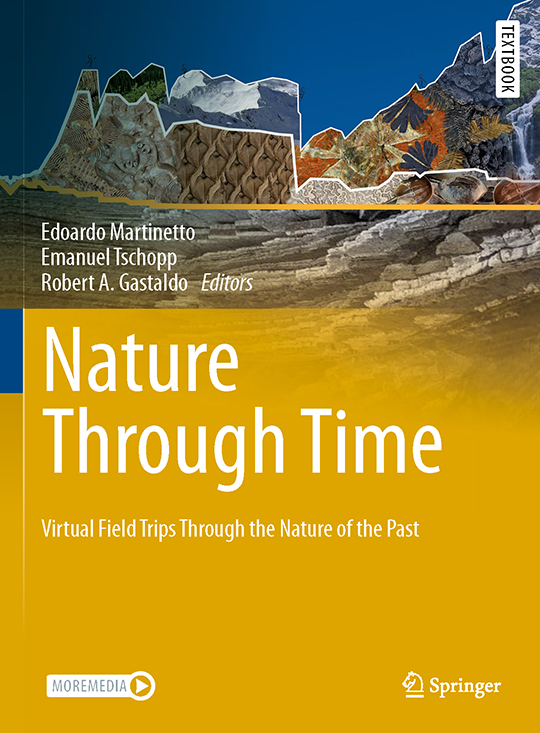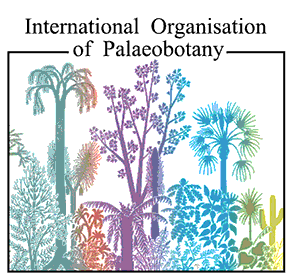Martinetto, E. Tschopp, E., and Gastaldo, R.A., eds., 2020, Nature Through Time: Springer Nature Switzerland, Cham, Switzerland, 474 p. ISBN 978-3-030-35057-4.

The IOP meeting in Padua, Italy, in 2014, began a resurgence of interest by members for the development of a textbook and web-based project to educate undergraduate and graduate students, hobbyists, enthusiasts, and the general public, at large, about the effects of evolutionary and climatic changes to Earth’s terrestrial landscape over deep time. Thirteen chapters with 96 contributing authors simulates a historical walk through nature, teaching readers about the biodiversity on Earth in various eras with a focus on past terrestrial environments. The book presents our state-of-the-art understanding of the terrestrial plant-and-animal ecosystems, along with the pre- and post-Paleozoic marine biota, within the context of the evolution of natural systems. Vignettes, or postcards, of biomes and ecosystems, which have undergone major vegetational change in response to a variety of biotic and abiotic factors, are highlighted from across the globe. The outreach program provides a free set of lecture slides to instructors, students, and any interested individual in our planet’s history, regardless of whether the book has been purchased. The outreach program is maintained separately from Springer Publishing, and it is anticipated that each slide show will be updated periodically.
The book topics represent a broad paleoenvironmental spectrum of interests and educational modules, allowing for virtual visits to rich geological localities not often spotlighted in past or current textbooks. Eras and events that are discussed include, but are not limited to, the much varied Quaternary environments, the evolution of Earth’s biota during the Cenozoic, the rise of angiosperms, Mesozoic vertebrate evolution and ecosystems, the Permian mass extinction, the late Paleozoic glaciation and the Coal Farms, and the origin of the land plants and first trees in the Devonian-Ordovician. With state-of-the art expert scientific instruction on these topics and up-to-date and scientifically accurate illustrations, this book serves as an international course for students, teachers, and other interested individuals.
We understand that plants are not as “sexy” as animals, and most individuals take for granted the landscape around their home as being immutable. Today, changes in vegetation are thought, by many, to be associated with recent past-and-present deforestation, the planting of agricultural fields or construction of towns and cities, and/or the introduction of attractive taxa in a garden or municipal setting. These plantings reflect the available natural or hybridized species capable of thriving in such environments, and the species pool from which to select an ornamental or shade-providing tree is thought to have been a constant since civilization began more than 8500 years before present. As paleontologists, we understand that this short time span is a meager record of Earth’s history. But, to many, the concept of deep time is daunting, and data supporting biological change over that time frame are difficult to grasp. Demonstrating that our global flora evolved through time over many different phases may be less threatening to those with the belief of an immutable planet, and help to broaden an understanding of biological change. To accomplish these aims, the textbook begins in the present where the reader has some familiarity of plants and animals of the Pleistocene and Holocene. Each successive chapter travels backward in time where the familiar becomes less-and-less familiar, and non-analog states predominate. To the majority of readers, these non-analog terrains could well be similar to Pandora of Avatar fiction.
Some historians credit Frederick R. Barnard with the phrase “One look is worth a thousand words,” which appeared in a U.S. magazine, the Printer’s Ink, in the early 20th Century. Others note that the idea was not new to him, but predicated on idioms of the previous century, one of which appeared in an 1858 article of the The American Journal of Education entitled Catechism on Methods of Teaching, by Dr. Hermann Winner. “One fact well understood by observation, and well guided development, is worth a thousand times more than a thousand words.” Regardless of the phrase’s origin, the concept is fundamental to the success of Nature Through Time.
